“Somalia drought: The fight for survival as famine looms”, BBC News
By Andrew Harding, Baidoa, Somalia, 5 October 2022
Young children are dying in growing numbers in Somalia amid the worst drought to hit the country in 40 years. Government officials say that an even greater catastrophe could sweep the country within days or weeks unless more help arrives.
 IMAGE SOURCE, BBC/ ED HABERSHON
IMAGE SOURCE, BBC/ ED HABERSHONThe tears tumbled down 11-year-old Dahir’s hunger-hollowed cheeks.
“I just want to survive this,” he said quietly.
Seated beside the family’s makeshift tent, on the dusty plain outside the city of Baidoa, his weary mother, Fatuma Omar, told him not to cry.
“Your tears will not bring your brother back. Everything will be fine,” she said.
Fatuma’s second son, 10-year-old Salat, died of starvation two weeks ago, shortly after the family reached Baidoa from their village, three days’ walk away. His body is buried in the rocky earth a few metres from their new home – the grave already covered in litter and increasingly hard to spot as new arrivals set up camp around them.
“I cannot grieve for my son. There is no time. I need to find work and food to keep the others alive,” Fatuma said, cradling her youngest daughter, nine-month-old Bille, and turning to look at six-year-old Mariam as she gave a rasping cough.
On the other side of the dirt road that loops to the south-east, towards the coast and Somalia’s capital, Mogadishu, other displaced families told more grim stories of long treks across a drought-parched landscape in search of food.
”No strength to bury my daughter’
A new survey has shown that almost two-thirds of young children and pregnant women in the camps are suffering from acute malnutrition, which, along with a high death rate, could indicate that a localised declaration of famine is already overdue.
“I saw my daughter [three-year-old Farhir] die before me and I could do nothing,” said Fatuma, who had walked for at least 15 days with her nine children from a village called Buulo Ciir to reach Baidoa.
“I had been carrying her for 10 days. We had to leave her by the side of the road. We had no strength to bury her. We could hear the hyenas closing in,” she continued.
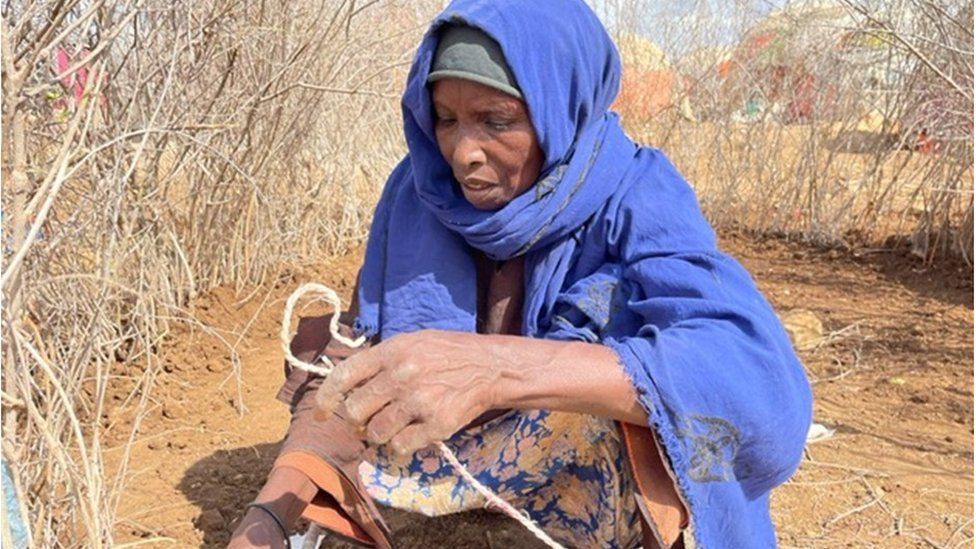 IMAGE SOURCE, BBC/ ED HABERSHON
IMAGE SOURCE, BBC/ ED HABERSHON“I’ve brought nothing with me. There is nothing left at home. The cattle are dead. The fields are dry,” said Habiba Mohamud, 50, clutching a piece of twine in one hand, and acknowledging that she will never return to her village.
A succession of droughts, turbo-charged by climate change, is now threatening to end a pastoral way of life that has endured for centuries across the Horn of Africa.
Like other new arrivals, Habiba was busy erecting a tent for her family from branches, twigs, and scavenged scraps of cardboard and plastic sheeting, hoping to finish it before the chill of night. Only after that could she turn to finding food and medical help for some of her five children.
On the admissions ward in the city’s main hospital, Dr Abdullahi Yussuf moved between beds, checking on his tiny, emaciated patients. Most were children between two months and three years old.
All were severely malnourished. Some had pneumonia and many were battling a new outbreak of measles too.
Few infants had the strength to cry. Several had badly damaged skin, broken by the swelling that sometimes accompanies the most extreme cases of hunger.
“So many die before they even reach a hospital,” said Dr Abdullahi, watching his team struggling to connect an intravenous tube to the arm of a moaning two-year-old.
‘It’s terrifying, people are dying’
Although Somali officials and international organisations have been sounding the alarm for months about an impending famine in this south-western region, Dr Abdullahi said his hospital was already short of basic items including nutritional supplements for children.
“Sometimes we lack supplies. It’s terrifying, actually, because people are dying, and we can’t support them. Our local government is not handling this well. It has not been planning for the drought or for the arrival of displaced families,” he said, with visible frustration.
A local government minister conceded there had been failings.
“We need to be faster than we are, and we need to be accurate… and more effective,” said Nasir Arush, Minister for Humanitarian Affairs for South West state, on a short visit to one of the camps around Baidoa. But more international support, he insisted, was key.
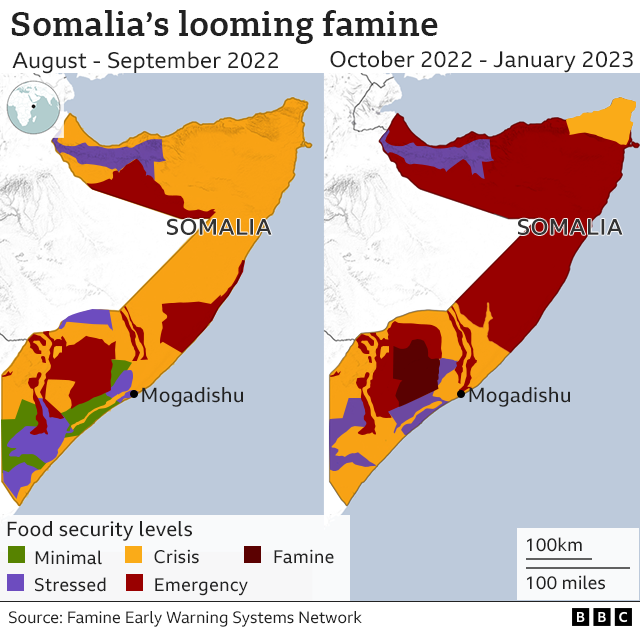
“If we don’t receive the aid we need, hundreds of thousands of people will die. The things we’re doing now we needed to do three months ago. In reality we are behind. Unless something happens [fast] I think something catastrophic will happen in this area,” he said.
The process of formally declaring a famine can be a complicated one, reliant on hard-to-pin-down data, and, often, political considerations.
Britain’s ambassador in Mogadishu, Kate Foster, described it as “essentially, a technical process”. She pointed out that during the 2011 drought “half of the 260,000 deaths happened before famine was declared”.
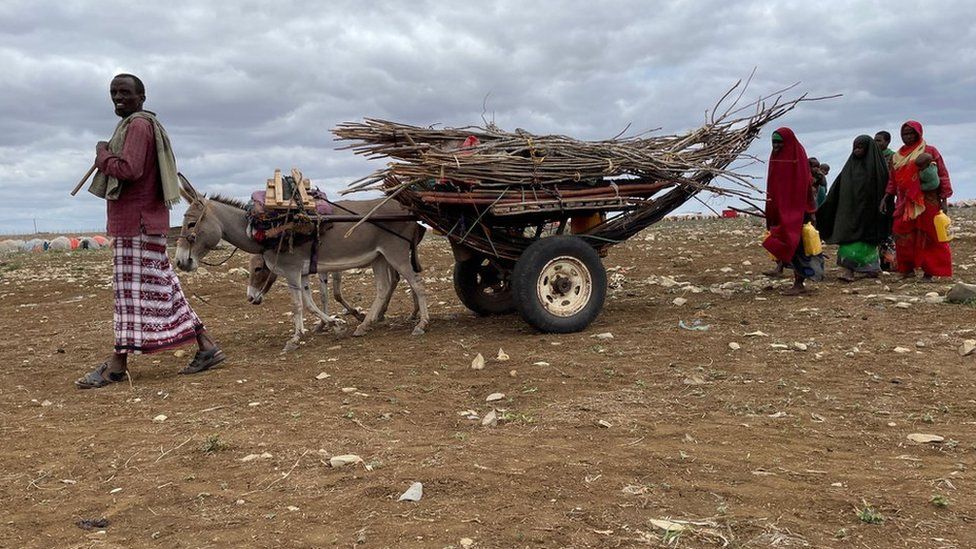 IMAGE SOURCE, BBC/ ED HABERSHON
IMAGE SOURCE, BBC/ ED HABERSHONThe presidential envoy leading Somalia’s international effort to secure more funding thanked the US government, in particular, for recent new funding, saying it “has given us hope”.
But Abdirahman Abdishakur warned that without more help, a localised crisis in one part of Somalia could quickly spin out of control.
“We were raising the alarm… but the response of the international community was not adequate,” Mr Abdishakur said.
“Famine is projected. It happens [already] in some places, some pockets, in Somalia, but still we can prevent the catastrophic one,” he continued, speaking by phone during a stopover in Toronto, Canada.
Women fleeing, men stay behind
Although estimates vary, the population of Baidoa has roughly quadrupled in the past few months, to around 800,000 people.
And any visitor will quickly notice one striking fact: almost all the new adult arrivals are women.
Somalia is at war. The conflict has endured, in different guises, since the central government collapsed three decades ago, and it continues to affect almost every part of the country, tearing men away from their families to fight for an array of armed groups.
Like most of those arriving in Baidoa, Hadija Abukar recently escaped from territory controlled by militant Islamist group al-Shabab.
“Even now I’m getting calls on my phone from the rest of my family. There is fighting there – between the government and al-Shabab. My relatives have run away and are hiding in the forest,” she said, seated beside her sickly child at a small hospital in Baidoa.
Other women spoke of husbands and older sons being blocked from leaving areas controlled by the militants, and of years of extortion by the group.
Baidoa itself is not quite surrounded by al-Shabab, but it remains a precarious place of refuge. International aid organisations, and foreign journalists, require heavy security to move around, and any travel beyond the city limits is considered extremely risky.
“We’re looking at populations that are under siege. Sometimes it feels quite hopeless,” said Charles Nzuki, who heads the UN children’s fund, Unicef, in central and southern Somalia.
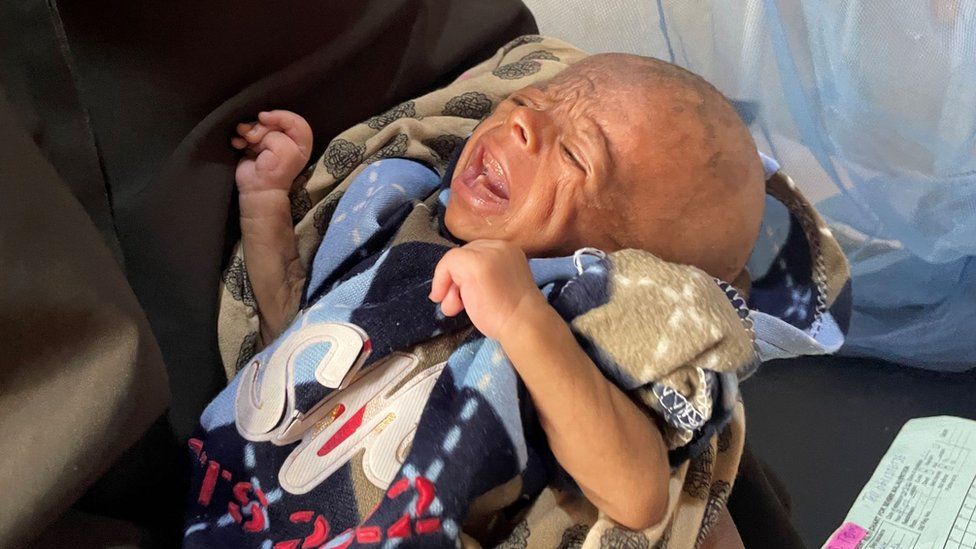 IMAGE SOURCE, BBC/ ED HABERSHON
IMAGE SOURCE, BBC/ ED HABERSHONAccording to some estimates, more than half the population affected by the current drought remains in areas controlled by al-Shabab. Strict US government rules blocking any assistance from benefitting designated terrorist groups have complicated efforts to reach many desperate communities.
But international organisations, and the Somali authorities, are working with smaller local partners to increase access and are now planning air drops into some contested territories.
Still, one aid worker, speaking off the record, acknowledged that it was almost impossible to guarantee that no food or funds were reaching al-Shabab.
“Let’s not be naïve, [al-Shabab] taxes everything, even cash donations,” they said.
Over the years, the militant group has established a reputation not just for violence and intimidation but for delivering justice in a country with a hard-earned reputation for official corruption.
In at least four villages close to Baidoa, al-Shabab runs a network of Sharia courts that are routinely used by the city’s residents and, reportedly, by people in Mogadishu and beyond, to settle business and land disputes.
Further to the north-east, a sudden uprising against al-Shabab has seen local communities and clan militias – now heavily backed by the central government – drive the group out of dozens of towns and villages in recent weeks.
The military successes have prompted a surge of optimism, but it is not clear if that will help in the fight against famine, or simply distract the Somali government.
“It might, or it might not [help]. I think it may create more [civilian] displacement. Or the government might liberate more areas and people might have more access [to aid]. So, we’re looking at it from all sides,” said local minister Nasir Arush.
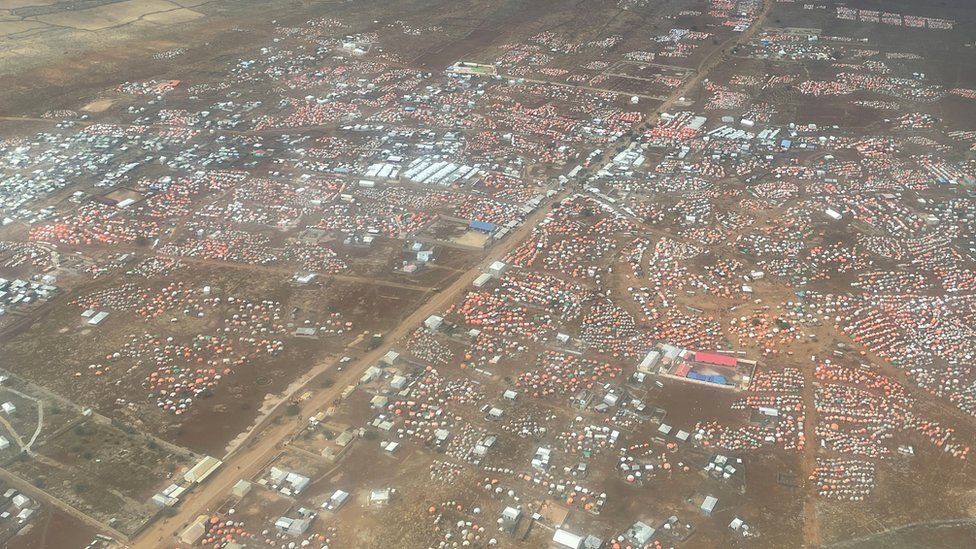 IMAGE SOURCE, BBC/ ED HABERSHON
IMAGE SOURCE, BBC/ ED HABERSHONIn Baidoa itself – a busy city of narrow, cobbled streets scarred by decades of conflict and neglect – the prices of basic goods, like rice, have doubled in the past month. Many residents blamed the drought, but others also looked further afield.
“Flour, sugar, oil – they’ve all risen by about the same amount. Sometimes we have to skip meals. I heard about the war between Russia and Ukraine. People say that is the root cause of these problems,” said Shukri Moalim Ali, 38, walking over to her dry well, and barren vegetable patch.
While the fight to ward off a deeper, spreading famine is the immediate focus in this region, Somalia’s new government is also looking ahead, seeking to address more existential questions about the future.
“It is a challenging task, to respond to the drought, to fight against al-Shabab, and to campaign to access [international] climate justice finance,” Abdirahman Abdishakur said.
“We have a young population, an enormous diaspora, and vibrant entrepreneurial skills. So that gives us hope. It’s challenging, but we don’t have an alternative.”